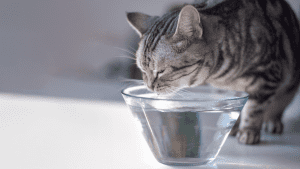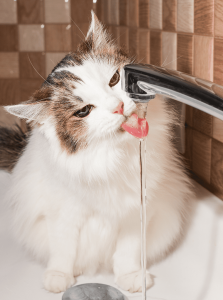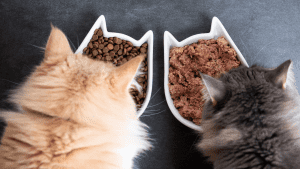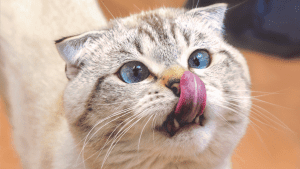
How can I get my cat to drink more water?
Why domestic cats are missing out on moisture and how to easily increase their water intake.
Historically, cats were by nature, desert-dwelling creatures who often could go months without a direct source of water. This was because their primary source of moisture was through ingesting their prey’s intestines which held absorbent amounts of water. Since then, the cats we keep in our homes have been largely domesticated, causing them to rely on the food we feed them for their meals instead of wild prey. Oftentimes, this means eating dry kibble foods, or a combination of wet and dry foods, and not getting the amounts of water in their diet to stay in a healthy standard of hydration.
The saying may be, “you can lead a horse to water, but you can’t make him drink,” but getting a 1,000-pound equine to imbibe may be way easier than convincing an 8-pound feline to take a few sips if they’re not in the mood. Keeping kitties hydrated, however, is critical to their health.
Why is it important to keep cats hydrated?
Like our bodies, cats’ bodies are made mostly of water, which is essential to keep all systems flowing. In cats, water helps to:
- Regulate temperature
- Aid digestion
- Lubricate joints
- Deliver oxygen and other nutrients throughout the body
- Maintain circulation
- Keep organs functioning smoothly
In addition, increasing water intake can help cats who have issues like kidney disease, diabetes, hyperthyroidism, and digestive trouble.
How much water should my cat drink?
In general, cats should get about one ounce of water per pound of body weight each day. Your cat’s needs can fluctuate based on climate, activity level, medications, and medical conditions. Cats don’t necessarily need to drink that water, however,as long as they consume it—which can also be done through the moisture content in wet food, like canned food, rehydrated food, or pre-packaged raw food diets.
Try sneaking water into their food
Parents have been doing it for ages: hiding vegetables in their children’s meals, and you can do the same for your fur children by adding a bit of water to your cat’s kibbles. Cats can be super picky—and super sensitive to change—so sprinkle just a spoonful or two at a time at first. Let the kibbles soak up the water, and hopefully, your cat will enjoy the same meal with a little higher moisture content.

Whatever you do, do not force your cat to eat the wetted-down food. You don’t want to cause them to boycott food they already like.
Dry pet food typically contains 10 to 12% moisture, while wet food has 75-78%, according to the Pet Food Institute. So, gradually switching from kibble to wet foods like canned food, will automatically increase your cat’s water consumption. If they don’t like the first kind you offer, don’t give up. There are so many different recipes and textures, from whole fish, bite-sized morsels in gravy, to pate, that it may take a few (or many) tries to find something they like. Again, when transitioning to a new food, do so gradually over several days.
Find the best bowl(s)
Whisker fatigue. Yep, it’s a thing. And it’s why providing an appropriate bowl may be key to getting cats to drink more water. Whisker fatigue, also known as whisker stress, is when cats experience sensory overload as their sensitive whiskers repeatedly touch a surface. This is why cats prefer bowls that let them drink without their whiskers making contact with the side of the bowl. Wide, shallow bowls that let them keep their whiskers above the bowl as they drink are best. This is also why keeping bowls filled to the brim invites cats to drink more than a half-filled bowl.
Cats can be picky not only about the size but also about the type of bowl you offer. Stainless steel bowls are the best anti-microbial option. But as cat parents know, your cat likes what they like. Try ceramic or glass bowls. Try elevating bowls off the ground, which may be more comfortable for some cats.

It’s best to offer drinking options with wide bases that are less likely to tip and spill if your cat likes to play with their paw in the water. And, don’t limit yourself to official “cat bowls.” There are a lot of different options on the market to explore!
Offer multiple bowls
Offer a few bowls throughout your home to increase the likelihood of drinking. This is also important if you have more than one cat, as one may become territorial and not let their sibling share “their” personal water source.
Freshen and wash often
Many cats are the feline equivalent of the barista’s nightmare coffee customer—the one with so many special instructions they don’t all fit written on the coffee cup. They are fantastically picky about the flavor, texture, and temperature of their refreshments. This is why it’s important to wash out the cat’s bowls frequently. Don’t simply top off their water. Instead, dump the old water and add completely new water for the freshest, most appealing flavor.
Lots of cats love drinking from a running water source rather than still water. In the wild, cats evolved to drink only from running water, which is less likely to make them sick, a predilection that still causes today’s domestic cats to turn their little whiskered noses up at still water in a bowl. There are tons of cat fountains designed to lure cats to drink without having to leave a faucet dripping and waste water. Just remember that like bowls, fountains need to be cleaned frequently, to prevent unhealthy bad-tasting bacterial buildup.
Placing a water bowl next to a timed, automatic feeder can also tempt cats to drink more. Set the feeder to release just a bit of food every few minutes at mealtime. Often, cats will take a sip of water as they wait for their next course to arrive.
Find a favorite flavor
Your cat’s preferred water flavor might not be straight from the tap. If they’re not drinking it, try using a filter or bottled water. You can also try flavoring their water with broth or tuna juice, though check with your vet regarding sodium content and be sure not to use broth that contains things like garlic and onions which are harmful to cats. Adding ice cubes made with a favorite flavor, like clam juice, can also tempt cats to drink more if they prefer their cocktails chilled.
If your cat’s drinking habits continue to worry you, it’s best to check with your vet. Not drinking can be a sign of other health issues so it’s important to have an expert help you determine if that’s the case.
Whatever you attempt in your quest to hydrate your kitty, don’t give him milk. Despite countless “Tom & Jerry” cartoons, adult cats are actually lactose intolerant. Instead, keep trying different food, water and delivery formats & flavors until you find one your cat enjoys (or at least tolerates) to keep them healthy—and happy.
 from KONG Company
from KONG Company



